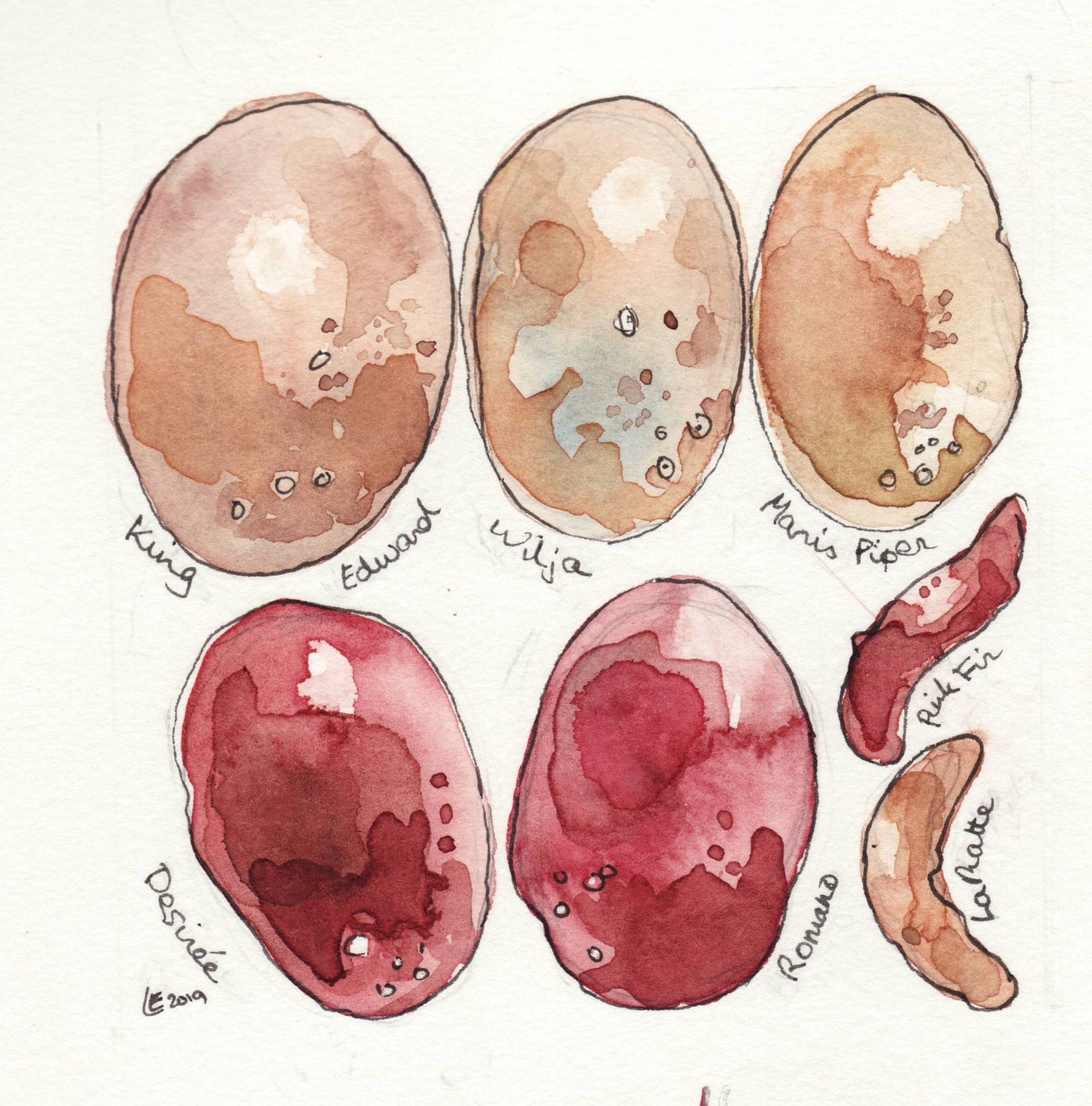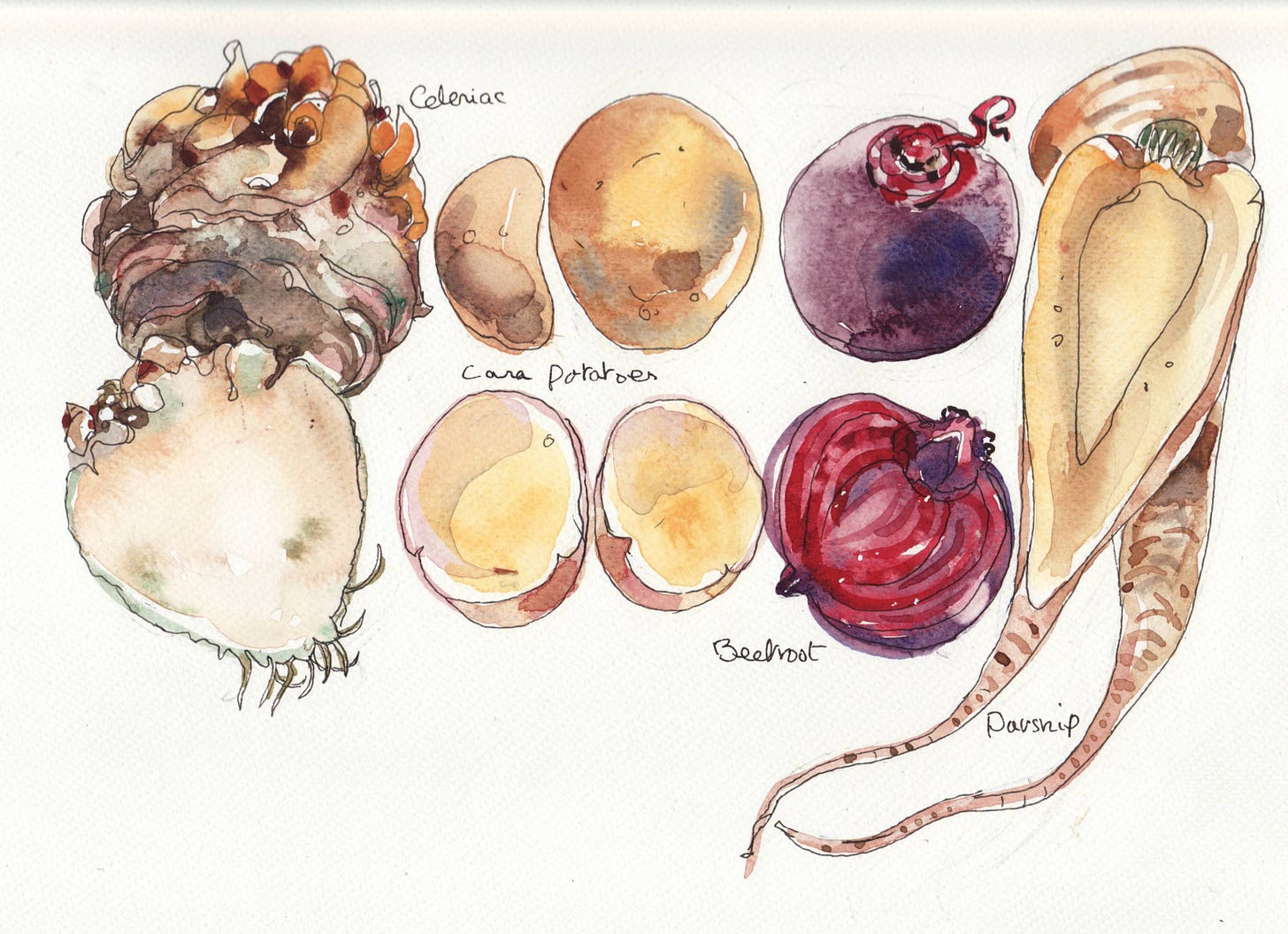Burns Night Special!
...including how to stuff your own haggis (first you need a sheep's stomach)
Tomorrow, January 25th , as anyone with a drop of Scottish blood in their veins won’t need reminding, is Burns Night, an occasion to be celebrated with music (bagpipes, naturally), poetry (Fair fa’ your honest sonsie face et al), the mighty haggis (Great Chieftan o’ the Pudding Race and so forth) washed down with good malt whisky and the possibility of treacle tart with a dollop of top-of-the-milk from the jug.
And while you’re about it, raise a glass to Customs & Excise, who were far-sighted enough to give employment to Scotland’s favourite prodigal poet. If Robert Burns had had a penny for every bottle of the peaty brew drunk in his honour ever since, he would not have died, as he did, with a pair of begging letters dropping from his pen. Scotland’s favourit son is best-remembered for Auld Lang Syne (the great rallying cry for national pride) and best-loved (early conservationist) for his lament for a field mouse crushed by the plough. A hero for our times.
Back to the pudding. It is not impossible to prepare your own haggis. It is, after all, simply a large boiling-sausage stuffed with oats and sheep’s innards. And I speak as one who has stuffed their own - nay, three of them, when checking the recipe for European Peasant Cooking with raw materials from the butcher in Tobermoray on the isle of Mull in the Hebrtides, at a time when I contributing a cookery column to The Scotsman, Edinburgh’s national newspaper - and deil tak the hindmost if I got it wrong.
In spite of all the sword-wielding romance, the haggis is neither more nor less than a practical response to the need to preserve a pershable foodstuff, offal, that might otherwise go to waste. An oversize boiling sausage (much like the French andouillette or Italy’s cotechino), the traditional outer casing is a sheep’s stomach filled with ready-cooked innards, chopped and mixed with pinhead oats (cracked whole-grain, rather than rolled as for porridge). Tough cuts of meat - mutton, lamb, venison - can replace the offal, but the oats are non-negotiable. Onion and pepper are the traditional flavourings, but latitude is allowed in choice of herbs and spices.
As for the casing, a lamb or veal caul (the stretchy, fatty membrane traditionally used as a sausage-casing). Failing this, Marion McNeill in The Scots Kitchen (published 1929, known to all traditional Scottish cooks as 'The Bible) allows that the stuffing may be boiled for four hours in a buttered jar or basin instead of a stomach bag. In extremis, she continues, the stuffing-mix can even be cooked like a stew in a saucepan, although the result will lack the characteristic slightly-sour taste imparted by the rennetting element present in the stomach lining (the stuff that turns milk into curds for cheese).
How to Stuff Your Own Haggis
The classic recipe for haggis as (ostensibly) prepared by Mistress Margaret Dods - according to the tangled mythology that surrounds Sir Walter Scott’s fictional Cleikum Inn - was awarded first prize in Edinburgh’s Great Haggis Festival of 1880. For the basics to serve 6-10, depending on appetites and size of your chosen container, provide yourself with plenty of elbow room, a robust attitude, a large stewpan and a container of sufficient size to serve 6-10 (depending on appetites and a sufficiency of whisky to wash it all down).
For the stuffing: the (traditional) basics are a set of sheep or lamb’s pluck (liver, heart and lungs), three handfuls (about 6 oz) coarsely cracked or pin-head oatmeal (not porridge or rolled oats), 3-4 medium onions (plenty) and pound of suet (the fat that surrounds the kidneys of any meat-animal), salt and plenty of cracked pepper (preferably white rather than black).
Tackle the stomach-bag first. Turn it inside out, then scrub and scrape it in several changes of cold water. Scald it and leave it to soak for a few hours in water and salt. Meanwhile put the oatmeal, well spread out on a baking tray, to toast golden brown in a hot oven, 400F, for 10 minutes.
Now wash the pluck well. Drain the liver and heart of its blood (your butcher will probably already have done this). If you cannot get the lungs, the kidneys and tongue will do instead. Put the pluck into cold salted water and bring to the boil. Skim and then simmer for at least an hour, till firm.
Drain the pluck and check it over, removing the black bits and veins. Grate the liver and chop the rest of the meat. (You may not need all the liver - half is usually enough). Chop the suet if it is not already prepared, and rub out the membrane-scraps with well-floured hands. Mince the onions finely.
Mix the meats, suet, and onions together, and spread them out on the table. Sprinkle the oatmeal over the top. Season well with salt and a heavy hand with the pepper-grinder. Possible additional flavourings include lemon zest and juice, cayenne pepper, thyme. Pack it all into the container - no more half-full to allow room for the oats to swell - moisten with enough broth from the cooking, or plain water, so that the mixture looks juicy rather than dry. Press out the air and sew up the bag (if necessary).
Place the haggis on an upturned saucer in a pan of boiling water or stock. Prick the bag with a needle when it first swells. Simmer it for three hours if the haggis is a large one. To reheat from room-temperature, simmer for another hour.
Serve with well-buttered mashed swede (Swedish turnip) and potato, served seperately or beaten together (Clapshot). Pour a dram of whisky on the haggis and set it alight when it comes to table, if you must. Better still, drink it yourself while you’re cooking (you’ll need it).
Note: it’s possible to make a haggis mixture with liver alone, using the pan or bowl method. But don’t omit the suet (vegetable suet is an option).
To reheat a ready-made haggis
Bearing mind that your (butcher’s) haggis is a fully-cooked storable sausage, it’s just a matter of reheating. I like it tipped out of the container and given a light roasting in a frying-pan on top-heat, though that would not please traditionalists. A two-pound haggis serves 4-6, depending on appetites.
Place the haggis in a large pan of simmering water. Bring the water gently to the boil, allow a single belch, and then turn the heat back down to a simmer. Allow 25-30 minutes to heat it right through. The water can be kept at a gentle simmer for an hour if necessary.
Note: if you bring the haggis to the boil from cold and leave it bubbling, it will burst. Alternatively, heat the haggis in a tightly-covered casserole or wrapped securely in foil, in a low oven for 30-40 minutes.
Serve with mashed turnips and potatoes - neeps and tatties, aka clapshot
Bowl-haggis
The haggis mixture can equally well be cooked in a bowl, like a steamed pudding. Or gently steamed, like a rissotto, in a heavy casserole on the stove or in the oven. The pinhead oatmeal is important - you can't get the necessary grainy result with rolled or porridge oats. If you can't find pinhead, give whole-grain oats a quick whizz in the coffee-grinder.
Serves 4-6
1 lb/500g lamb's liver and/or heart, trimmed
1 lb/500g onions
1 1/2 pints/1 l water
4 oz/100g pinhead oatmeal
4 oz/150g grated suet (kidney fat)
1 tablepoon dried thyme
Salt and plenty of freshly-ground white pepper
Simmer the liver and/or in the water with seasoning and one of the onions (quartered) for 30-40 minutes.
Meanwhile toast the oatmeal in a heavy pan or in the oven until nicely gilded.
As soon as the liver is firm and well-cooked, remove it with a draining spoon, discard the onion and reserve the stock.
Grate the liver and remaining onions (in a processor if you prefer), and stir in the toasted oatmeal. Season with salt and pepper and pack it into a bowl (it should come about a third of the way up) and moisten with enough stock to just cover - about a pint/450ml. Cover the bowl with a cloth tied on with string, with the ends knotted over to give you a handle (or cover with foil - not so easy to lift out).
Place on an upturned saucer in a roomy saucepan, pour in enough boiling water to come 2/3rds of the way up the bowl, lid the pan and leave the pan to simmer for 2 hours. Check and add more boiling stock or water as necessary.
Serve hot - warm, reekin’ - with mashed neeps and tatties, either mixed as Clapshot, or served separately. Mustard is possible but maybe a tad Sassenach (southerner and therefore English).
Clapshot (aka neeps-n-tatties)
Peel and chunk an appropriate amount of cooked, mashed turnips (preferably swede which is prettier, sweeter and smoother than white turnip) and an equal volume of main-crop potatoes (peeled or not, as you please). Drop into plenty of cold salted water in a roomy pan and simmer till really tender. Drain, return the mix to the pan, mash thoroughly with a great deal of butter and enough hot milk to soften. Taste and season with sea-salt and freshly-ground pepper. Beat it again till it’s really soft and smooth. More butter. That’s it.
p.s. the late great Catherine Brown is the go-to for all things Scottish. See Scottish Cookery, Scottish Seafood, A Year in a Scots Kitchen, Broths to Bannocks, Classic Scots Cookery.
p.p.s. I’ve not worked out how to drop an extra recipe(s) below the line for the happiness and joy of my paid-subscribers. If you feel you’re missing out, I love you anyway, but you have to subscribe to read all about Athol Brose.
Keep reading with a 7-day free trial
Subscribe to Elisabeth Luard's Cookstory to keep reading this post and get 7 days of free access to the full post archives.










